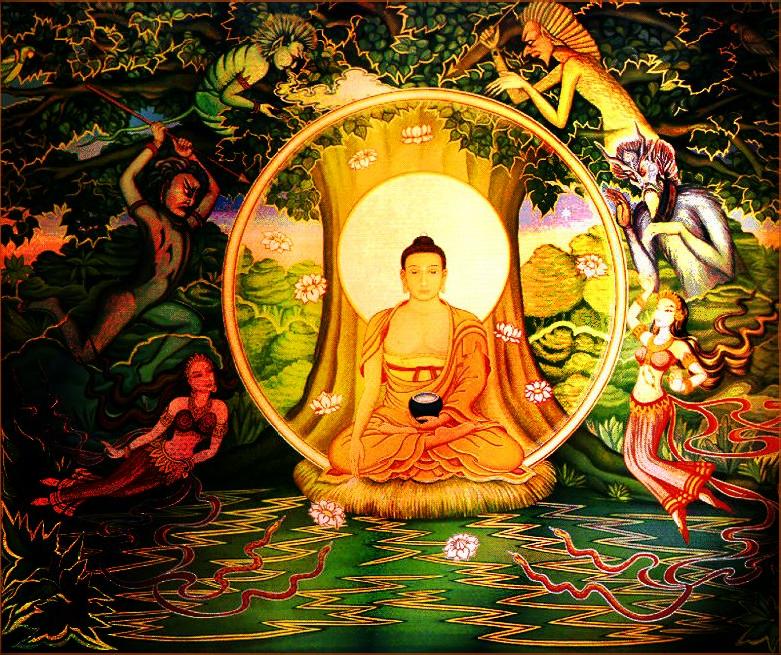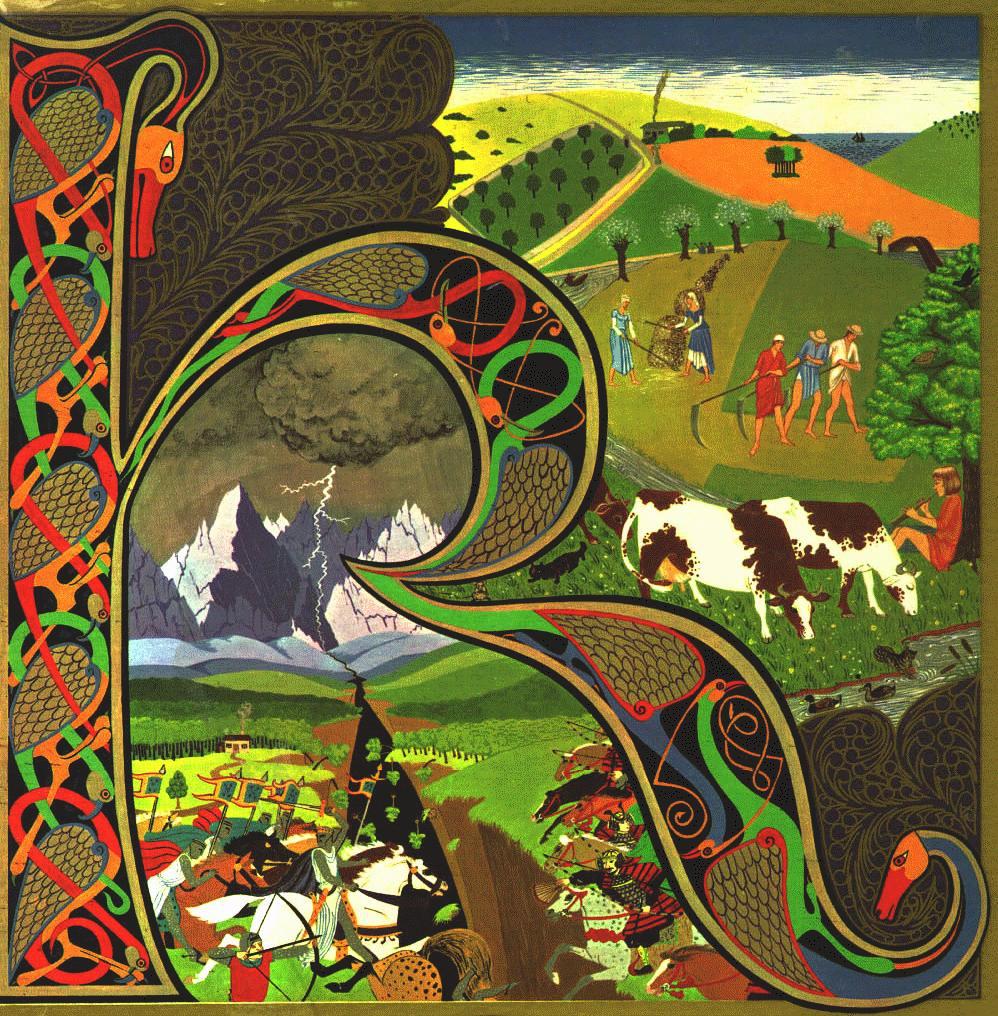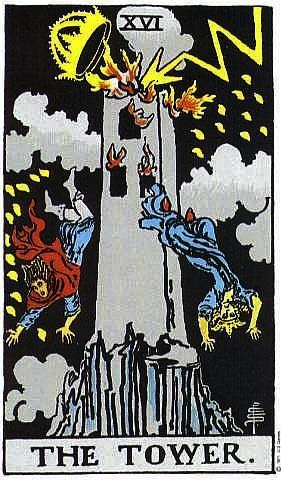"I saw an angel standing in the sun, who cried in a loud voice to all the birds
flying in midair, "Come, gather
together for the great supper of God, so that you may eat the flesh of kings,
generals, and mighty men, of
horses and their riders, and the flesh of all people, free and slave, small and
great. Then I saw the beast and the kings of the earth and their armies
gathered together to make war against the
rider on the horse and his army."
- Revelation 19:17-18, 19
"When the beard has for
the third time reached the last corner of the table, the end of the
world begins, a bloody battle is fought on the Walserfeld, Antichrist
appears, the angel-trumpets peal, and the Last of Days has dawned. The
Walserfeld has a withered tree, which has been cut down three times,
but its root has always sprouted and grown into a perfect tree again.
When next it begins to leaf, the terrible fight is near, and will open
when the tree bears fruit. Then shall Frederick hang his shield on the
tree, all men shall flock to it, and make such a slaughter that the
blood will run into the warriors' shoes, and the wicked men be slain by
the righteous."
- Grimm's Teutonic Mythology at The Midhnott Sol
Regintroth
(Vol. 3 Ch. 32)
"Why is it that in practically all the ancient literatures spiritual teaching
was given in the vernacular of the battlefield? The Bhagavad-Gita, for
instance, tells of the conflict between the opposing armies of the Kurus
and the Pandavas. In the Germanic and Scandinavian mythologies there
is the constant battling between the gods and the heroes; so also in the
Greek, Egyptian, Persian, and Babylonian mythologies -- all are alike in
this respect."
- The Primeval Wisdom-Teaching
"Men generally find it very difficult to deprive themselves of graven images,
of special incarnations of the
divine
and the functional equivalent of graven images in modern secular faiths
are very special events (the
Revolution, past or to come, natural selection, national liberation, or
whatever) inside the world."
- Ernest Gellner
"The word Apocalypse is interesting. Its vulgar meaning is misconstrued
from the final book of the Bible, Revelations, which Saint John the
Divine wrote after obtaining in a vision on the Grecian isle of Patmos.
The Saint describes an end of time, a resurrection of the souls of the
dead, a divine last judgement, followed by a grand entry of the souls of
the blessed into Paradise. Need we say more? R.D. Laing points out
that if you scrutinise the text, you will not find a single indication that
he was talking about an external phenomenon! The word itself, is
Greek, simply means "revelation," or more precisely, the uncovering of
something that was hidden."
- Inner Apocalypse
"This mention of Moses has become a shackle on
men's minds -- they think these stories happened
long ago... Moses and Pharoah are in your own
existence -- you must seek these two adversaries in
yourself."
- The Sufi Path of Love: The Spiritual Teachings of Rumi, p. 274
-Inner War
"The greatest war is the war against
our selves."
- Mohammed
"Now the dark night deepens. As our outer and inner worlds
dissolve, we lose our sense of reference. There arises a
great sense of unease and fear, leading students into a
realm of fear and terror. "Where is there any security?"
"Wherever I look, things are dissolving." In these stages we
can experience this dissolution and dying within our own
body. We may look down and see pieces of our body
seeming to melt away and decay, as if we were a corpse. We
can see ourselves dying, or having died, in a thousand ways,
through illness, battles, and misfortune. At this point other
powerful visions can arise, visions of the death of others,
visions of wars, dying armies, funeral pyres, or charnel
grounds."
- The Dark Night
"Many of the alchemical texts relate "tales of horror" (dismemberment,
being mashed into oblivion) which relate the death of the ego. This is a
necessary step to allowing the divine (the gold) to enter into the "space"
which was formerly occupied by the renegade ego."
- Alchemy Forum
"In Oriental art there may be no more evocative
portrayal of what Rudolf Otto calls the mysterium
tremendum than the wrathful deities of Tibetan
Tantric Buddhism. Fearful in form, wreathed in
flames. adorned with garlands of human heads, and
brandishing dagger and skull-cup, their painted
images conjure the feelings of dread and fascination
which Otto describes in The Idea of the Holy. In
this seminal work, he sets out to describe the
central element of religious experience such that
there is "no religion in which it does not live as
the real innermost core, and without it no religion
would be worthy of the name."
- Approaching the Numinous: Rudolf Otto and Tibetan tantra
"One must not fear the Wrathful Deities, but must realize the gifts they have
to offer and
realize that they come from you. They are part of your consciousness. When one
embraces the Wrathful Deities one becomes enlightened.
Do not flee these deities they are coming from your own mind."
- The Tibetan Book of the Dead and Karma
"Because these hallucinations are products of the mind,
the Buddhist deities described in the book will not
apply to everyone. A Christian will have visions that
reflect his own beliefs, and so will a Moslem. For example
it would be reasonable to assume a Christian would see
visions of Jesus during the time of the peaceful deities,
and of Satan during the wrathful deities stage."
- The Chonyid Bardo
And it would be reasonable to assume that Rumi or Frederick II would see
visions of Mongol warriors.
return to page index
site index
As previously discussed in chapter five,
The Battle of Glass Tears
is depicted on the album cover as a clash between Teutonic Knights and Mongol
warriors. Historically, these two factions met only once, at the Battle of
Liegnitz, during the reign of Frederick II.
"What the Russians
then called their Mongol conquers
was the "Tartars"--invaders come
from Tartarus, the deepest part of
Hell. However, this was a deliberate
modification of the Persian word
tātār, which just meant a kind of Turk,
though the Mongols, of course, were
not Turks. But then, as the Mongols
appeared out of nowhere from the
Steppe, arriving from origins far
beyond the knowledge of Russians or
Persians, no one really knew who they
were or where they were from. To
Europeans, they seemed like the
Scourge of God."
- The Mongol Khans
"I am the Flail
of God. If you had not committed great sins, God would not have sent a
punishment like me upon you!"
- Temujin, Chinggis, Jenghiz The Conqueror of Asia and Eastern Europe
"If we are to understand the poetry of Jalal al-Din Rumi, we should know
that..."The Song of the Reed" was written
by a man who, in a single event lost his whole family, all his neighbors, the
surrounding community and the nation in
which he had trusted for protection. As we have seen, from Balkh Jalal al-Din
Rumi fled before the Mongols to the
Iranian heartland and ended up in Konya, in modern Turkey, where he composed
the Mathnawi. It begins with
"The Song of the Reed." "God giveth and God taketh away" was the order of the
day; the Mongols could not but
be regarded as the scourge of Allah descending upon rebellious communities. "Of
Him we are and to Him we return"
was the only phrase that could soothe the pain of separation from loved ones."
- Iran and Islam to AD 1400
Remarkably, Rumi, Gini Barris (who designed the cover of
Lizard
) and Frederick II all portray the Mongols as representatives from the
underworld, the scourge of God.
"When the first rumors of the Mongol invasion of Russia and
Hungary reached Europe early in the thirteenth century, Frederick
II of Germany wrote letters to his brother monarchs describing the
imminent peril to the West:
'Bursting forth from the abodes of Tartarus, the Horde is
even now battering like a sudden tempest at Germany,
the 'door of Christendom'.
(aka: Rupert's "rain tree shaded lawn")
- Ominous New Directions
"Everything is number " said Pythagoras. The numerical mystic takes this maxim
very literally. The Universe and all
its aspects are governed by the number and the idiosyncrasies of the
number. Three are the trinity, and six the perfect
number. In 1240, the triumphal year of the reign of Frederick II of Sicily,
western Europe was itself crossed through with
rumors of the approach of a great king from the distant East, master of an
immense territory, that inexorably began
a slow cadence towards the West. The Islamic kingdoms were falling one
after the other under their sword. Some Christians
interpreted this as an omen of the coming of the legendary one, Prester
John, who would unite in Jerusalem the
kings of the West and would seal the destiny of the Islamic religion. The
Jews of Europe, for their own reasons, maintained that this Eastern monarch was
the Messiah King, the son of David, and proposed that Europe receive him with
joy and celebration. Other Christians, although conforming to the messianic
interpretation, maintained
that this messķah was their own King Frederick II, stupor ET dominis mundi,
wonder and master of the world, one of the most remarkable intellects to have
ever occupied a throne.
What was the foundation of this belief in the coming of messiah? Simply,
that year 1240 of the Christian calendar
corresponded with year 5000 of the Hebrew calendar, and that, according to
certain theories, the Messiah would have to
appear at the beginning of the sixth millenium. There is a piece of number
mysticism here that is
incredible for the modern mind. The Eastern king was neither Prester John
nor the Messiah, but
Batu Khan, grandson of Gengis Khan and founder of the Golden Horde, that
broke through to blood and fire until Liegnitz, in
Silesia."
- Numerical Mysticism
Buddha, like Christ in the wilderness, faced his trials. While under the bodhi
tree, he encountered the terrifying visions found at this stage of the
spiritual journey.

"As he persisted in his deepest meditation, Mara, the personification of severe
impediments
on the narrow pathway to truth, sought to distract him with his vast hordes of
demonic
tempters, ranging from hideous emblems of terror and torment to ethereal
purveyors of
ecstasy and enchanting reminiscence. Buddha calmly confronted and renounced all
alike,
calling upon bhumi, the earth, as his sole witness. According to the Padhana
Sutta, Buddha
once depicted Mara's array of distractions thus:
Lust is your first army, and dislike for the higher life the second; the third
is hunger and
thirst, and the fourth craving; the fifth army consists of torpor and sloth,
and the sixth is
fear; the seventh is doubt, the eighth hypocrisy and obduracy; the ninth
includes gain,
praise, honour and glory; and the tenth is looking down on others whilst
exalting self.
Such are your armies, Mara, and none who are weak can resist them. Yet only by
conquering them is bliss attained."
- Buddha and the Path to Enlightenment
Instructions for the Wrathful Visions
"You are now entering Second Bardo nightmares.
Recognize them.
They are your own thought-forms made visible and audible.
They are products of your own mind with its back to the wall.
They indicate that you are close to liberation.
Do not fear them.
No harm can come to you from these hallucinations.
They are your own thoughts in frightening aspect.
They are old friends.
Welcome them. Merge with them. Join them.
Lose yourself in them.
They are yours.
Whatever you see, no matter how strange and terrifying,
Remember above all that it comes from within you.
Hold onto that knowledge.
As soon as you recognize that, you will obtain liberation.
If you do not recognize them,
Torture and punishment will ensue.
But these too are but the radiances of your own intellect.
They are immaterial.
Voidness cannot injure voidness.
None of the peaceful or wrathful visions,
Blood-drinking demons, machines, monsters, or devils,
Exist in reality
Only within your skull.
(They are glass tears.)
This will dissipate your fear. Remember it well."
- The Psychedelic Experience
"The Herukas (wrathful visions)
described as "blood-drinking," angry or "terrifying" deities - are merely
the dynamic aspect of enlightenment, the process of becoming a Buddha, of
attaining illumination, as symbolized by the Buddha's struggle with the
Hosts of Mara.... The ecstatic figures, heroic and terrifying, express the
act of breaking through towards the unthinkable, the intellectually
"Unattainable." They represent the leap over the chasm, which yawns between
an intellectual surface consciousness and the intuitive supra-personal
depth-consciousness." (Govinda, op. cit., pp. 198, 202.)]
- The Psychedelic Experience
|



 "The tower is the World Axis, the center of being, and the divine illumination
has struck at its core, demolishing it,
but igniting in its depths the spark of new life. The falling figures,
representing head and heart (reason and
emotion), were imprisoned in the tower's dogma and defenses. Though now
released, before they can be
reborn they must "come back to the earth" of the body and must be submerged in
the Abyssal waters of the
unconscious, which have been quickened by the lightning."
"The tower is the World Axis, the center of being, and the divine illumination
has struck at its core, demolishing it,
but igniting in its depths the spark of new life. The falling figures,
representing head and heart (reason and
emotion), were imprisoned in the tower's dogma and defenses. Though now
released, before they can be
reborn they must "come back to the earth" of the body and must be submerged in
the Abyssal waters of the
unconscious, which have been quickened by the lightning."






















